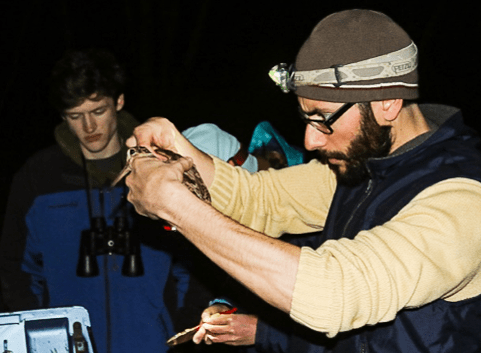Photo courtesy of Stephen Brenner. Former MSC student, Stephen Brenner, holds and studies an American Woodcock that was caught during the study.
Graduates, volunteers, professors, the Rhode Island Department of Environmental M
The research has been conducted at the University of Rhode Island for many years now and the knowledge on the bird keeps growing.
The professor in charge of the research is Scott McWilliams, professor of wildlife ecology and physiology. He directs the program and makes sure the team has funding to conduct this research.
“So we’re going into our 12th year of studying the American Woodcock,” McWilliams said. “The main focus is how forest management influences the distribution of the bird. The reason why that particular species is important is
McWilliams shared many details of the bird that were discovered over the years. These findings have concluded how the birds mate, where they migrate to and more. All of the research conducted has lead the team to really be able to know the bird on a whole other level. The graduate student currently taking part in the research is Erin Harrington, a graduate student studying science communication. Harrington has worked with the American Woodcock for awhile now and has become very familiar with its manners.
“
Through the numerous years of research, McWilliams also found out a little bit of where the birds’ original habitat was. All of these pieces of information allow the team members to put the puzzle pieces together and truly figure out all the mannerisms of this bird.
“It’s a shore bird so it’s like the shore bird you see at the beach that runs in and out of the waves but it is one of our only shore birds that evolved,” McWilliams said. “They like to live in forests that are quite wet, have moist soils and young forests, so they won’t be deep in the forest. They are always living in areas that has openings.”
In order to obtain all of this information, the team must evaluate real statistical facts on these birds and must have evidence to support the facts. Harrington stated that they gather a group of volunteers from all over Rhode Island to go into the forest and watch their patterns and wait for the mating ritual to begin. This group effort allows the team to uncover this vital evidence.
“The standard approach we use would be to catch bird males in the spring, and the occasional female, put trackers on them and track them several times throughout the day,” McWilliams said. “We have basically used radio kilometry and movement studies to discern kinds of places they travel to. Just this last year, the technology for these transmitters has gotten to the point where they’ve gotten small enough so we can use small satellite transmitters to send the signal to the satellite and back down that last almost the whole year. For the first time we are going to be able not only to know what they do in Rhode Island during the year, but where Rhode Island birds end up going for the winter and how long they stay.”
There are many people contributing to this research, so there are many different moving parts. Harrington is focusing on her own project with the bird, called Project Timberdoodle. This focuses solely on the breeding and mating ritual of the American Woodcock. She has decided to take her background in science communication and apply it to the research of this bird. Most importantly both Harrington and McWilliams have stressed the importance of the research and why it needs to be conducted.
“It’s an important bird and interesting research that we should care about because we know that the population has been decreasing by 1 percent the past few years,” said Harrington. “I think the research connects a lot of different types of people, different fields, disciplines and interests. It encourages a lot of different types of dialogue. It helps all Rhode Islanders get more engaged in science.”





